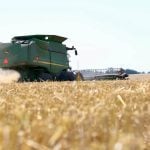I was at two announcements Friday here in Winnipeg that both focused on using specialization and high quality as weapons for Canadians to use to bash a way into foreign markets.
One was at the Canadian International Grains Institute, a fabulous agency here at Portage and Main that brings in buyers of Canadian grain from around the world and shows them how to use it in a way that makes their lives easier, makes them more money, and gums up their machinery less than crappy non-Canadian grain. This institute is often taken for granted by Canadian farmers, but it shouldn’t be. It really is a unique agency that does things that other countries’ grain industries don’t attempt, and that wins us sales. I say that because I’ve met dozens of people from around the world who have attended CIGI courses and who say that what they learn in Winnipeg makes them more likely to keep buying Canadian grain because they know what they’re getting and how to handle it. Two of the best selling features of Canadian crops are 1) we produce lots of specialized classes and qualities of crops, far more than most of our competitors, and have something for whatever the buyer needs, and 2) we impose tight standards on the quality of export crops, so buyers know what they’re going to get when they order it. But neither point # 1 nor point # 2 mean much if you don’t know what we have on offer, or how to use it. So that’s where CIGI comes in.
Read Also

Crop profitability looks grim in new outlook
With grain prices depressed, returns per acre are looking dismal on all the major crops with some significantly worse than others.
Politicians of all stripes, and farmer organizations all support the institute because they know it does good, hard work for Canadian grain and pulse sales. But how aware are farmers?
The second announcement was at the National Centre for Livestock and the Environment, a University of Manitoba research centre that does pioneering work on the environmental impact and interactions of livestock with land, water and air. It’s a worthy institution too, but it was just the setting for a hog industry announcement, so I won’t describe it much here. At this announcement Canadian Pork Council chair Jurgen Preugschas talked about how a chunk of federal money will help develop traceability, quality and safety of Canadian pork and how these factors will help get Canada into more markets, and bigger pieces of existing markets. He said it well, so here’s what he said:
“We as a Canadian industry have realized in the last few years with the collapse of the American dollar and the rise of our Canadian dollar that we cannot and will not be the low cost producer in the world. We can’t compete against other countries on price. So that means we can’t just be another commodity producer. To be competitive we need to adopt some of the latest technologies and we need to differentiate our product. That’s where we feel our future lies.”
“We’re moving closer to gaining a significant competitive advantage globally also on the national traceability program . . . We as a hog industry do believe that that is just another thing that sets us apart from our competitors around the world. When we’re the leading edge of this it gives us the opportunity to differentiate from others who are not prepared to move and more ahead in a very progressive fashion.”
Personally, I think we do have a future as a country that is a bulk commodity pork producer, and I suspect we will be able to compete on price. The price advantage some other regions have are often due to unsustainable production practices, low health standards, government programs. Those things don’t last the ages. But I don’t think it’ll be be dumb, unthinking bulk production, but a highly specialized and refined bulk production system that operates on a truly lowest-cost basis that is as possible here as anywhere else. That’s happening to a degree now, but no doubt it will keep advancing. Low cost (if not the lowest) bulk production combined with research that produces top quality pork and quality and safety assurance seems a pretty sure recipe for long term success.
That’s especially true if, as Preugschas says, other countries don’t think it’s worth the bother to undertake these daunting challenges. Our willingness in both livestock and grain production to embrace these pains-in-the-butt will be our future market-gaining edge.















